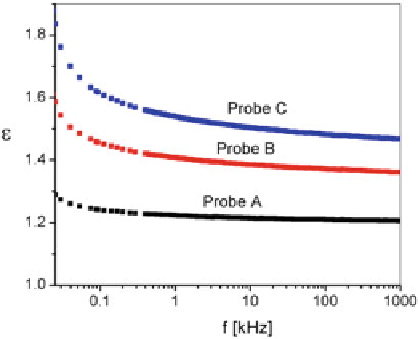Environmental Engineering Reference
In-Depth Information
Fig. 14.11 The frequency
dependence of the measured
real component,
ε
of the
effective complex dielectric
permittivity of the probes A,
B, and C
dependence for the real component,
ε
, of the effective complex dielectric permit-
tivity of the probes A, B, and C.
The frequency dependence of the real part of the CM factor for the mentioned
powder samples was determined by the dielectric measurements using the
Maxwell-Wagner model [
47
]:
2
K
R
¼
ε
þ ε
2
4
;
ð
14
:
25
Þ
2
ε
þ
4
ε þ
and consequently, knowing the frequency dependence of the real component of
complex permittivity,
, we obtained the frequency dependence of the real part of
CM factor for the probes A, B, and C, represented in Fig.
14.12
:
One observes that the real component of the CM factor acquires highest values at
low frequencies and decreases continuously but remaining positive while frequency
increases. More precisely, in the investigated frequency range, the behavior is
described by three distinct variation regions: first, it decreases slightly for frequen-
cies less than 200 Hz, then falls sharply for frequencies between 200 and 4 kHz, and
finally remains nearly constant for higher frequencies. Due to the positive values of
the real part of CM factor, it follows that the use of positive DEP force is
appropriate for manipulating the ash nanoparticle from the flue gas. For further
analysis regarding the filtration process, only devices working at frequencies up to
200 Hz are of interest, because in this domain, the CM factor has the highest value,
and consequently one reaches the highest strength of pDEP force acting on nano-
particle in the flue gas. Therefore, for further calculations we will use the value
K
R
¼
ε
1.


